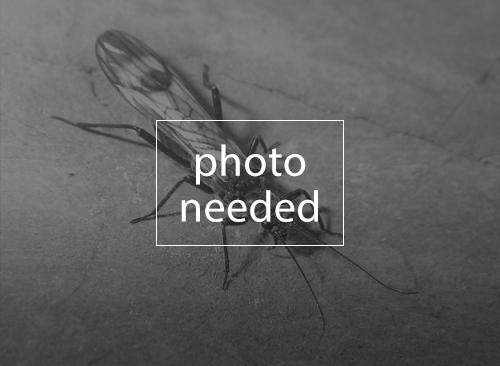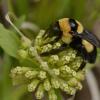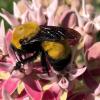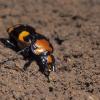
Hylaeus anomalus is a large bee endemic to the island of Oahu in Hawaii. It is easily recognizable due to the red head of the female and orange base of the male abdomen. It was formerly relatively commonly found in the leeward Koolau Mountains above Honolulu, but has not been recorded since the 1930s. The reasons for its decline are unknown.
Description
Males
Face marks yellow and highly variable; at greatest development trident-shaped with lateral lines extending ¾ of the way along the inner edge of the eyes and a central mark extending up the clypeus to between the antennae. Sometimes the central mark is reduced to a transverse line at the apex of the clypeus, or the lateral marks may also be reduced. Segments 1-3 of abdomen sometimes dull red. Thorax with unusually dense punctation, less than a pit width apart; abdomen with distinct punctures.
Females
The head and antennae are red, a unique trait in Hawaiian bees. The first segment of the abdomen is also red. Punctation as in the male.
Hylaeus anomalus is larger and more robust than most Hawaiian species, though smaller than its close relatives. It is a member of a group of species with distinct punctation of the abdomen, including H. akoko and H. satelles. It is most similar to H. gliddenae of the island of Hawaii, which has the abdomen all red.
Taxonomic Status
Hylaeus anomalus was described as Nesoprosopis anomala by Perkins (1899). Nesoprosopis was reduced to a subgenus of Hylaeus by Meade-Waldo (1923). The most recent taxonomic treatment was Daly and Magnacca (2003).
Hylaeus anomalus inhabits wet to mesic forests. Nests have been documented from stems of Pipturus albidus (mamaki) and Boehmeria grandis (akolea) (Williams 1927). It has been recorded visiting flowers of Psychotria (kopiko) and Acacia koa (koa) (Swezey 1922; Williams 1927), and probably visits Metrosideros polymorpha (ohia) as well.
Hylaeus anomalus is apparently restricted to the upper elevation forests of the Koolau range on Oahu. All collection records are from the leeward southern Koolaus, above Honolulu. However, little collecting has been done in the northern Koolaus, which are less accessible.
Xerces Red List Status: Critically Imperiled (Possibly Extinct)
Other Rankings:
Canada – Species at Risk Act: N/A
Canada – provincial status: N/A
Mexico: N/A
USA – Endangered Species Act: Species of Concern
USA – state status: HI: Species of Concern
NatureServe: GNR
IUCN Red List: N/A
This species was apparently commonly encountered, though perhaps not particularly abundant, in the early period of Hawaiian insect collecting (1892-1930). There followed a long period when very little collecting of Hylaeus was done in Hawaii. Surveys of the middle and southern Koolaus by K. Magnacca, 1999-2002, failed to find any specimens.
Originally, U.S. Federal listings of rare and endangered species classed H. anomalus as a “Category 2” Candidate Species about which more information was needed before it could be considered for listing. This status was based on recognition that Hawaiian bees in general were becoming rarer and little was known about their conservation status. Data were never gathered to document whether or not this species should be proposed for listing. It is currently considered to be a “Species of Concern” or a “Special Status Species” by the U.S. Fish and Wildlife Service and the Hawaii Division of Forestry and Wildlife.
Explicit threats to H. anomalus are unknown. Habitat loss is the most common threat to Hawaiian bees. Large areas of native forest exist in the upper ridges of the Koolaus, and bees are found relatively abundantly there. However, it is possible that H. anomalus favored the lower, drier forests around 1200-1600 ft that are now largely gone. When Perkins collected in Hawaii, the Koolau slopes were largely denuded by goats and it was easy to find patches of native vegetation that remained; they have now been grown over by exotic plants, and such patches (if they still exist) are impossible to find. Lack of nest sites due to declines in the populations of wood-boring Plagithmysus longhorn beetles may also be a factor, but has not been investigated.
The top priority is to identify extant populations and document the continued existence of the species. All areas where H. anomalus is likely to be found are protected under the auspices of the State of Hawaii, the U.S. Fish and Wildlife Service, or the U.S. Army, though they may not be actively managed for habitat conservation. Research is needed to identify why this and certain other Oahu species have disappeared or precipitously declined while other apparently sympatric species have thrived.
Daly, H. V., and K. N. Magnacca. 2003. Insects of Hawaii, Vol. 17: Hawaiian Hylaeus (Nesoprosopis) Bees (Hymenoptera: Apoidea). University of Hawaii Press, Honolulu. 234 pp.
Meade-Waldo, G. 1923. Hymenoptera, fam. Apidae, subfam. Prosopidae, fasc. 181. Pp. 1-45 in P. Wytsman (ed.), Genera Insectorum. L. Desmet-Verteneuil, Brussels.
Perkins, R. C. L. 1899. Hymenoptera, Aculeata. Pp. 1-115 in D. Sharp (ed.), Fauna Hawaiiensis, Vol. 1. Cambridge University Press, Cambridge, United Kingdom.
Swezey, O. H. 1922. Notes and Exhibitions: Nesoprosopis anomala and Nesoprosopis unica. Proceedings of the Hawaiian Entomological Society 5:14.
Williams, F. X. 1927. Notes on the habits of the bees and wasps of the Hawaiian Islands. Proceedings of the Hawaiian Entomological Society 6:425-464.
Citation
Magnacca, K. N. 2005. Species Profile: Hylaeus anomalus. In Shepherd, M. D., D. M. Vaughan, and S. H. Black (Eds). Red List of Pollinator Insects of North America. CD-ROM Version 1 (May 2005). Portland, OR: The Xerces Society for Invertebrate Conservation.
Profile prepared by Karl Magnacca, USGS-BRD, Kilauea Field Station





